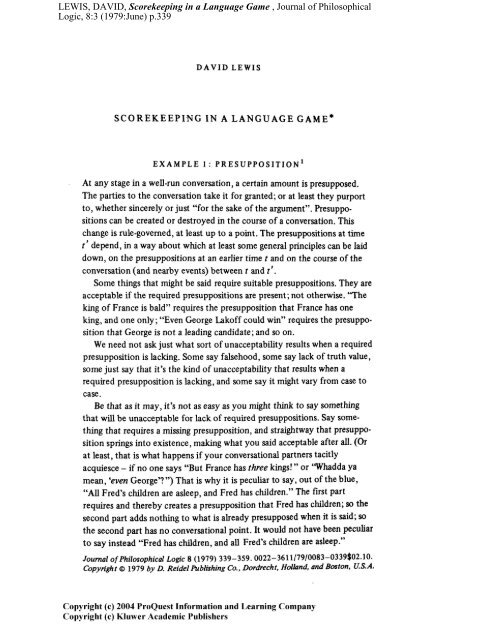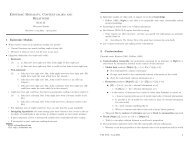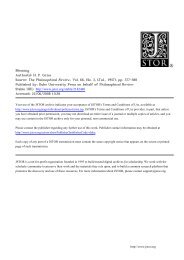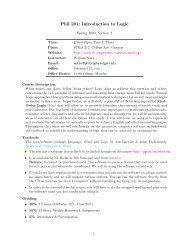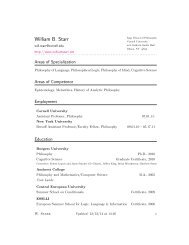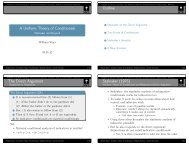LEWIS, DAVID, Scorekeeping in a Language Game ... - Will Starr
LEWIS, DAVID, Scorekeeping in a Language Game ... - Will Starr
LEWIS, DAVID, Scorekeeping in a Language Game ... - Will Starr
Create successful ePaper yourself
Turn your PDF publications into a flip-book with our unique Google optimized e-Paper software.
<strong>LEWIS</strong>, <strong>DAVID</strong>, <strong>Scorekeep<strong>in</strong>g</strong> <strong>in</strong> a <strong>Language</strong> <strong>Game</strong> , Journal of PhilosophicalLogic, 8:3 (1979:June) p.339
340 <strong>DAVID</strong> <strong>LEWIS</strong>I said that presupposition evolves <strong>in</strong> a more or less rule-governed waydur<strong>in</strong>g a conversation. Now we can formulate one important govern<strong>in</strong>g rule :call it the rule of accommodation for presupposition.If at time t someth<strong>in</strong>g is said that requires presupposition Pto be acceptable, and if P is not presupposed just before t,then - ceteris paribus and with<strong>in</strong> certa<strong>in</strong> limits - presuppositionP comes <strong>in</strong>to existence at t.This rule has not yet been very well stated, nor is it the only rule govern<strong>in</strong>gthe k<strong>in</strong>ematics of presupposition. But let us bear it <strong>in</strong> m<strong>in</strong>d nevertheless,and move on to other th<strong>in</strong>gs.For some reason - coercion, deference, common purpose - two people areboth will<strong>in</strong>g that one of them should be under the control of the other. (Atleast with<strong>in</strong> certa<strong>in</strong> limits, <strong>in</strong> a certa<strong>in</strong> sphere of action, so long as certa<strong>in</strong>conditions prevail.) Call one the slave, the other the master. The control isexercised verbally, as follows.At any stage <strong>in</strong> the enslavement, there is a boundary between somecourses of action for the slave that are permissible, and others that are not.The range of permissible conduct may expand or contract. The master shiftsthe boundary by say<strong>in</strong>g th<strong>in</strong>gs to the slave. S<strong>in</strong>ce the slave does his best tosee to it that his course of action is a permissible one, the master can controlthe slave by controll<strong>in</strong>g what is permissible.Here is how the master shifts the boundary. From time to time he saysto the slave that such-and-such courses of action are impermissible. Anysuch statement depends for its truth value on the boundary between what ispermissible and what isn't. But if the master says that someth<strong>in</strong>g is impermissible,and if that would be false if the boundary rema<strong>in</strong>ed stationary,then straightway the boundary moves <strong>in</strong>ward. The permissible range contractsso that what the master says is true after all. Thereby the mastermakes courses of action impermissible that used to be permissible. But fromtime to time also the master relents, and says to the slave that such-and-suchcourses of action are permissible. Or perhaps he says that some of such-andsuchcourses of action are permissible, but doesn't say just which ones. Thenthe boundary moves outward. The permissible range expands, if need beCopyright (c) 2004 ProQuest Information and Learn<strong>in</strong>g CompanyCopyright (c) Kluwer Academic Publishers
SCOREKEEPING IN A LANGUAGE GAME 34 1(and if possible), so that what the master says is true. Thereby the mastermakes courses of action permissible that used to be impermissible.The truth of the master's statements about permissibility - one aspectof their acceptability - depends on the location of the boundary. Theboundary shifts <strong>in</strong> a rule-governed way. The rule is as follows; call it therule of accommodation for permissibility.If at time t someth<strong>in</strong>g is said about permissibility by themaster to the slave that requires for its truth the permissibilityor impermissibility of certa<strong>in</strong> courses of action, and ifjust before t the boundary is such as to make the master'sstatement false, then - ceteris paribus and with<strong>in</strong> certa<strong>in</strong>limits - the boundary shifts at t so as to make the master'sstatement true.Aga<strong>in</strong>, this is not a very satisfactory formulation. For one th<strong>in</strong>g, the limitsand qualifications are left unspecified. But more important, the rule asstated does not say exactly how the boundary is to shift.What if the master says that some of such-and-such courses of actions arepermissible, when none of them were permissible before he spoke. By therule, some of them must straightway become permissible. Some - but whichones? The ones that were closest to permissibility beforehand, perhaps. Welland good, but now we have a new problem. At every state there is not onlya boundary between the permissible and the impermissible, but also arelation of comparative near-permissibility between the courses of action onthe impermissible side. Not only do we need rules govern<strong>in</strong>g the shift<strong>in</strong>gboundary, but also we need rules to govern the chang<strong>in</strong>g relation of comparativenear-permissibility. Not only must we say how this relation evolveswhen the master says someth<strong>in</strong>g about absolute permissibility, but also wemust say how it evolves when he says someth<strong>in</strong>g - as he might - about cornparativenear-permissibility. He might say, for <strong>in</strong>stance, that the most nearlypermissible courses of action <strong>in</strong> a class A are those <strong>in</strong> a subclass A'; or thatsome courses of action <strong>in</strong> class B are more nearly permissible than any <strong>in</strong>class C. Aga<strong>in</strong> the rule is a rule of accommodation. The relation of comparativenear-permissibility changes, if need be, so that what the master says tothe slave is true. But aga<strong>in</strong>, to say that is not enough. It does not suffice todeterm<strong>in</strong>e just what the change is.Copyright (c) 2004 ProQuest Information and Learn<strong>in</strong>g CompanyCopyright (c) Kluwer Academic Publishers
342 <strong>DAVID</strong> <strong>LEWIS</strong>Those were Examples 1 and 2. Examples of what? I'll say shortly; but first,a digression.SCOREKEEPING IN A BASEBALL GAMEAt any stage <strong>in</strong> a well-run baseball game, there is a septuple of numbers(rV, rh, h, i, s, b, 0) which I shall call the score of that game at that stage.We recite the score as follows: the visit<strong>in</strong>g team has rv runs, the home teamhas rh runs, it is the hth half (h be<strong>in</strong>g 1 or 2) of the ith <strong>in</strong>n<strong>in</strong>g; there are sstrikes, b balls, and o outs. (In another term<strong>in</strong>ology, the score is only the<strong>in</strong>itial pair (rv, rh >, but I need a word for the entire septuple.) A possiblecodification of the rules of baseball would consist of rules of four differentsorts.(1) Specifications of the k<strong>in</strong>ematics of score. Initially, the score is(0,0,1,1, 0,0,0). Thereafter, if at time t the score is s, and if betweentime t and time t' the players behave <strong>in</strong> manner m, then at time t' thescore is s', where s' is determ<strong>in</strong>ed <strong>in</strong> a certa<strong>in</strong> way by s and m.(2) Specifications of correct play. If at time t the score is s, and ifbetween time 1 and time t' the players behave <strong>in</strong> manner m, then theplayers have behaved <strong>in</strong>correctly. (Correctness depends on score: what iscorrect play after two strikes differs from what is correct play after three.)What is not <strong>in</strong>correct play accord<strong>in</strong>g to these rules is correct.(3) Directive requir<strong>in</strong>g correct play. All players are to behave, throughoutthe game, <strong>in</strong> such a way that play is correct.(4) Directives concern<strong>in</strong>g score. Players are to strive to make the scoreevolve <strong>in</strong> certa<strong>in</strong> directions. Members of the visit<strong>in</strong>g team try to make rvlarge and rh small, members of the home team try to do the opposite.(We could dispense with roles of sorts (2) and (3) by add<strong>in</strong>g an eighthcomponent to the score which, at any stage of the game, measures theamount of <strong>in</strong>correct play up to that stage. Specifications of correct playare then <strong>in</strong>cluded among the specifications of the k<strong>in</strong>ematics of score, andthe directive requir<strong>in</strong>g correct play becomes one of the directives concem<strong>in</strong>gscore .)Copyright (c) 2004 ProQuest Information and Learn<strong>in</strong>g CompanyCopyright (c) Kluwer Academic Publishers
SCOREKEEPING IN A LANGUAGE GAME 343Rules of sorts (1) and (2) are sometimes called constitutive rules. Theyare said to be ak<strong>in</strong> to def<strong>in</strong>itions, though they do not have the form of def<strong>in</strong>itions.Rules of sorts (3) and (4) are called regulative rules. They are ak<strong>in</strong>to the straightforward directives "No smok<strong>in</strong>g!" or "Keep left!".We could expla<strong>in</strong> this more fully, as follows. Specifications of sorts (1)and (2) are not themselves def<strong>in</strong>itions of "score" and "correct play". But theyare consequences of reasonable def<strong>in</strong>itions. Further, there is a systematicway to construct the def<strong>in</strong>itions, given the specifications. Suppose we wishto def<strong>in</strong>e the score function : the function from game-stages to septuples ofnumbers that gives the score at every stage. The specifications of the k<strong>in</strong>ematicsof score, taken together, tell us that the score function evolves <strong>in</strong>such-and-such way. We may then simply def<strong>in</strong>e the score function as thatfunction which evolves <strong>in</strong> such-and-such way. If the k<strong>in</strong>ematics of score arewell specified, then there is one function, and one only, that evolves <strong>in</strong> theproper way; and if so, then the score function evolves <strong>in</strong> the proper way ifand only if the suggested def<strong>in</strong>ition of it is correct. Once we have def<strong>in</strong>edthe score function, we have thereby def<strong>in</strong>ed the score and all its componentsat any stage. There are two outs at a certa<strong>in</strong> stage of a game, for<strong>in</strong>stance, if and only if the score function assigns to that game-stage aseptuple whose seventh component is the number 2.Turn next to the specifications of correct play. Taken together, they tellus that correct play occurs at a game-stage if and only if the players'behavior at that stage bears such-and-such relation to score at that stage.This has the form of an explicit def<strong>in</strong>ition of correct play <strong>in</strong> terms of currentbehavior. If current score has already been def<strong>in</strong>ed <strong>in</strong> terms of thehistory of the players' behavior up to now, <strong>in</strong> the way just suggested, thenwe have def<strong>in</strong>ed correct play <strong>in</strong> terms of current and previous behavior.Once score and correct play are def<strong>in</strong>ed <strong>in</strong> terms of the players' behavior,then we may elim<strong>in</strong>ate the def<strong>in</strong>ed terms <strong>in</strong> the directive requir<strong>in</strong>g correctplay and the directives concern<strong>in</strong>g score. Thanks to the def<strong>in</strong>itions constructedfrom the constitutive rules, the regulative rules become simplydirectives to strive to see to it that one's present behavior bears a certa<strong>in</strong>rather complicated relation to the history of the players' behavior <strong>in</strong> previousstages of the game. A player might attempt to conform to such adirective for various reasons: contractual obligation, perhaps, or a conventionalunderstand<strong>in</strong>g with his fellow players based on their common <strong>in</strong>terest<strong>in</strong> enjoy<strong>in</strong>g a proper game.Copyright (c) 2004 ProQuest Information and Learn<strong>in</strong>g CompanyCopyright (c) Kluwer Academic Publishers
344 <strong>DAVID</strong> <strong>LEWIS</strong>The rules of baseball could <strong>in</strong> pr<strong>in</strong>ciple be formulated as straighforwarddirectives concern<strong>in</strong>g behavior, without the aid of def<strong>in</strong>able terms for scoreand its components. Or they could be formulated as explicit def<strong>in</strong>itions ofthe score function, the components of score, and correct play, followed bydirectives <strong>in</strong> which the newly def<strong>in</strong>ed terms appear. It is easy to see whyneither of these methods of formulation has found favor. The first methodwould pack the entire rulebook <strong>in</strong>to each directive; the second would packthe entire rulebook <strong>in</strong>to a s<strong>in</strong>gle prelim<strong>in</strong>ary explicit def<strong>in</strong>ition. Understandablyaverse to very long sentences, we do better to proceed <strong>in</strong> our moredevious way.There is an alternative analysis - the baseball equivalent of operationalismor legal realism. Instead of appeal<strong>in</strong>g to constitutive rules, we might<strong>in</strong>stead claim that the score is, by def<strong>in</strong>ition, whatever some scoreboard saysit is. Which scoreboard? Various answers are defensible: maybe the visiblescoreboard with its arrays of light bulbs, maybe the <strong>in</strong>visible scoreboard <strong>in</strong>the head umpire's head, maybe the many scoreboards <strong>in</strong> many heads to theextent that they agree. No matter. On any such view, the specifications ofthe k<strong>in</strong>ematics of score have a changed status. No longer are they constitutiverules ak<strong>in</strong> to def<strong>in</strong>itions. Rather, they are empirical generalizations,subject to exceptions, about the ways <strong>in</strong> which the players' behavior tendsto cause changes on the authoritative scoreboard. Under this analysis, it isimpossible that this scoreboard fails to give the score. What is possible isthat the score is <strong>in</strong> an abnormal and undesired relation to its causes, forwhich someone may perhaps be blamed.I do not care to say which analysis is right for baseball as it is actuallyplayed. Perhaps the question has no determ<strong>in</strong>ate answer, or perhaps it hasdifferent answers for formal and <strong>in</strong>formal baseball. I only wish to dist<strong>in</strong>guishthe two alternatives, riot<strong>in</strong>g that both are live options.This ends the digression. Now want to propose some general theses aboutlanguage - theses that were examplified by Examples 1 and 2, and that willbe exemplified also by several other examples.CONVERSATIONAL SCOREWith any stage <strong>in</strong> a well-run conversation, or other process of l<strong>in</strong>guistic<strong>in</strong>teraction, there are associated many th<strong>in</strong>gs analogous to the componentsCopyright (c) 2004 ProQuest Information and Learn<strong>in</strong>g CompanyCopyright (c) Kluwer Academic Publishers
SCOREKEEPING IN A LANGUAGE GAME 345of a baseball score. I shall therefore speak of them collectively as the scoreof that conversation at that stage. The po<strong>in</strong>ts of analogy are as follows.(1) Like the components of a baseball score, the components of a consationalscore at a given stage are abstract entities. They may not benumbers, but they are other set-theoretic constructs: sets of presupposedpropositions, boundaries between permissible and impermissible courses ofaction, or the like.(2) What play is correct depends on the score. Sentences depend fortheir truth value, or for their acceptability <strong>in</strong> other respects, on the componentsof conversational score at the stage of conversation when they areuttered. Not only aspects of acceptability of an uttered sentence maydepend on score. So may other semantic properties that play a role <strong>in</strong> determ<strong>in</strong><strong>in</strong>gaspects of acceptability. For <strong>in</strong>stance, the constituents of an utteredsentence - subsentences, names, predicates, et,c. - may depend on the scorefor their <strong>in</strong>tension or extension.(3) Score evolves <strong>in</strong> a more-or-less rule-governed way. There are rulesthat specify the k<strong>in</strong>ematics of score:Or at least:If at time t the conversational score is s, and if between timet and time t' the course of conversation is c, then at time t'the score is sf, where s' is determ<strong>in</strong>ed <strong>in</strong> a certa<strong>in</strong> way by sand c.. . . then at time t' the score is some member of the class Sof possible scores, where S is determ<strong>in</strong>ed <strong>in</strong> a certa<strong>in</strong> way bys and c.(4) The conversationalists may conform to directives, or may simplydesire, that they strive to steer certa<strong>in</strong> components of the conversationalscore <strong>in</strong> certa<strong>in</strong> directions. Their efforts may be cooperative, as when allparticipants <strong>in</strong> a discussion try to <strong>in</strong>crease the amount that all of themwill<strong>in</strong>gly presuppose. Or there may be conflict, as when each of twodebaters tries to get his opponent to grant him - to jo<strong>in</strong> with him <strong>in</strong> presuppos<strong>in</strong>g- parts of his case, and to give away parts of the contrary case.(5) To the extent that conversational score is determ<strong>in</strong>ed, given thehistory of the conversation and the rules that specify its k<strong>in</strong>ematics, theserules can be regarded as constitutive rules ak<strong>in</strong> to def<strong>in</strong>itions. Aga<strong>in</strong>,Copyright (c) 2004 ProQuest Information and Learn<strong>in</strong>g CompanyCopyright (c) Kluwer Academic Publishers
346 <strong>DAVID</strong> <strong>LEWIS</strong>constitutive rules could be traded <strong>in</strong> for explicit def<strong>in</strong>itions: the conversationalscore function could be def<strong>in</strong>ed as that function from conversationstagesto n-tuples of suitable entities that evolves <strong>in</strong> the specified way.Alternatively, conversational score might be operationally def<strong>in</strong>ed <strong>in</strong>terms of mental scoreboards - some suitable attitudes - of the parties tothe conversation. The rules specify<strong>in</strong>g the k<strong>in</strong>ematics of conversational scorethen become empirical generalizations, subject to exceptions, about thecausal dependence of what the scoreboards register on the history of theconversation.In the case of baseball score, either approach to the def<strong>in</strong>ition of scoreand the status of the rules seems satisfactory. In the case of conversationalscore, on the other hand, both approaches seem to meet with difficulties. If,as seems likely, the rules specify<strong>in</strong>g the k<strong>in</strong>ematics of conversational scoreare seriously <strong>in</strong>complete, then often there may be many candidates for thescore function, different but all evolv<strong>in</strong>g <strong>in</strong> the specified way. But also itseems difficult to say, without risk of circularity, what are the mentalrepresentations that comprise the conversationalists' scoreboards.It may be best to adopt a third approach - a middle way, draw<strong>in</strong>g onboth the alternatives previously considered. Conversational score is, by def<strong>in</strong>ition,whatever the mental scoreboards say it is; but we refra<strong>in</strong> from try<strong>in</strong>gto say just what the conversationalists' mental scoreboards are. We assumethat some or other mental representations are present that play the role of ascoreboard, <strong>in</strong> the follow<strong>in</strong>g sense: what they register depends on thehistory of the conversation <strong>in</strong> the way that score should accord<strong>in</strong>g to therules. The rules specify<strong>in</strong>g the k<strong>in</strong>ematics of score thereby specify the roleof a scoreboard; the scoreboard is whatever best fills this role; and the scoreis whatever this scoreboard registers. The rules specify<strong>in</strong>g the k<strong>in</strong>ematics ofscore are to some extent constitutive, but on this third approach they enteronly <strong>in</strong> a roundabout way <strong>in</strong>to the def<strong>in</strong>ition of score. It is no harm if theyunderdeterm<strong>in</strong>e the evolution of score, and it is possible that score sometimesevolves <strong>in</strong> a way that violates the rules.RULES OF ACCOMMODATIONThere is one big difference between baseball score and conversational score.Suppose the batter walks to first base after only three balls. His behaviorwould be correct play if there were four balls rather than three. That's justCopyright (c) 2004 ProQuest Information and Learn<strong>in</strong>g CompanyCopyright (c) Kluwer Academic Publishers
SCOREKEEPING IN A LANGUAGE GAME 347too bad - his behavior does not at all make it the case that there are fourballs and his behavior is correct. Baseball has no rule of accommodation tothe effect that if a fourth ball is required to make correct the play thatoccurs, then that very fact suffices to change the score so that straightwaythere are four balls.<strong>Language</strong> games are different. As I hope my examples will show, conversationalscore does tend to evolve <strong>in</strong> such a way as is required <strong>in</strong> order tomake whatever occurs count as correct play. Granted, that is not <strong>in</strong>variablebut only a tendency. Granted also, conversational score changes for otherreasons as well. (As when someth<strong>in</strong>g conspicuous happens at the scene of aconversation, and straightway it is presupposed that it happened.) Still, Isuggest that many components of conversational score obey rules of accommodation,and that these rules figure prom<strong>in</strong>ently among the rules govern<strong>in</strong>gthe k<strong>in</strong>ematics of conversational score.Recall our examples. Example 1 : presupposition evolves accord<strong>in</strong>g to arule of accommodation specify<strong>in</strong>g that any presuppositions that are requiredby what is said straightway come <strong>in</strong>to existence, provided that nobodyobjects. Example 2: permissibility evolves accord<strong>in</strong>g to a rule of accommodationspecify<strong>in</strong>g that the boundaries of the permissible range of conductshift to make true whatever is said about them, provided that what is said issaid by the master to the slave, and provided that there does exist some shiftthat would make what he says true. Here is a general scheme for rules ofaccommodation for conversational score.If at time t someth<strong>in</strong>g is said that requires component sn ofconversational score to have a value <strong>in</strong> the range r if what issaid is to be true, or otherwise acceptable; and if sn does nothave a value <strong>in</strong> the range r just before t; and if such-and-suchfurther conditions hold; then at t the score-component sntakes some value <strong>in</strong> the range r.Once we have this scheme <strong>in</strong> m<strong>in</strong>d, I th<strong>in</strong>k we will f<strong>in</strong>d many <strong>in</strong>stances of it.In the rest of this paper I shall consider some further examples. I shall havelittle that is new to say about the <strong>in</strong>dividual examples. My <strong>in</strong>terest is <strong>in</strong> thecommon pattern that they exhibit.Copyright (c) 2004 ProQuest Information and Learn<strong>in</strong>g CompanyCopyright (c) Kluwer Academic Publishers
348 <strong>DAVID</strong> <strong>LEWIS</strong>EXAMPLE 3: DEFINITE DESCRIPTIONS~It is not true that a def<strong>in</strong>ite description "the F" denotes x if and only if x isthe one and only F<strong>in</strong> existence. Neither is it true that "the F" denotes x ifand only if x is the one and only F<strong>in</strong> some contextually determ<strong>in</strong>ed doma<strong>in</strong>of discourse. For consider this sentence: "The pig is grunt<strong>in</strong>g, but the pigwith floppy ears is not grunt<strong>in</strong>g" (Lewis). And this: "The dog got <strong>in</strong> a fightwith another dog" (McCawley). They could be true. But for them to be true,"the pig" or "the dog" must denote one of two pigs or dogs, both of whichbelong to the doma<strong>in</strong> of discourse.The proper treatment of descriptions must be more like this: "the F"denotes x if and only if x is the most salient F <strong>in</strong> the doma<strong>in</strong> of discourse,accord<strong>in</strong>g to some contextually determ<strong>in</strong>ed salience rank<strong>in</strong>g. The first ofour two sentences means that the most salient pig is grunt<strong>in</strong>g but the mostsalient pig with floppy ears is not. The second means that the most salientdog got <strong>in</strong> a fight with some less salient dog.(I shall pass over some complications. Never m<strong>in</strong>d what happens if twoF's are tied for maximum salience, or if no F is at all salient. More important,I shall ignore the possibility that someth<strong>in</strong>g might be highly salient <strong>in</strong>one of its guises, but less salient <strong>in</strong> another. Possibly we really need toappeal to a salience rank<strong>in</strong>g not of <strong>in</strong>dividuals but rather of <strong>in</strong>dividuals-<strong>in</strong>guises- that is, of <strong>in</strong>dividual concepts.)There are various ways for someth<strong>in</strong>g to ga<strong>in</strong> salience. Some have to dowith the course of conversation, others do not. Imag<strong>in</strong>e yourself with meas I write these words. In the room is a cat, Bruce, who has been mak<strong>in</strong>ghimself very salient by dash<strong>in</strong>g madly about. He is the only cat <strong>in</strong> the room,or <strong>in</strong> sight, or <strong>in</strong> earshot. I start to speak to you:The cat is <strong>in</strong> the carton. The cat will never meet our othercat, because our other cat lives <strong>in</strong> New Zealand. OurNew Zealand cat lives with the Cresswells. And there he'llstay, because Miriam would be sad if the cat went away.At first, "the cat" denotes Bruce, he be<strong>in</strong>g the most salient cat for reasonshav<strong>in</strong>g noth<strong>in</strong>g to do with the course of conversation. If I want to talk aboutAlbert, our New Zealand cat, I have to say "our other cat" or "ourNew Zealand cat". But as I talk more and more about Albert, and not anymore about Bruce, I raise Albert's salience by conversational means. F<strong>in</strong>ally,Copyright (c) 2004 ProQuest Information and Learn<strong>in</strong>g CompanyCopyright (c) Kluwer Academic Publishers
SCOREKEEPING IN A LANGUAGE GAME 349<strong>in</strong> the last sentence of my monologue, I am <strong>in</strong> a position to say "the cat"and thereby denote not Bruce but rather the newly-most-salient cat Albert.The rank<strong>in</strong>g of comparative salience, I take it, is another component ofconversational score. Denotation of def<strong>in</strong>ite descriptions is score-dependent.Hence so is the truth of sentences conta<strong>in</strong><strong>in</strong>g such descriptions, which is oneaspect of the acceptability of those sentences. Other aspects of acceptability<strong>in</strong> turn are score-dependent: non-triviality, for one, and possibility ofwarranted assertion, for another.One rule, among others, that governs the k<strong>in</strong>ematics of salience is a ruleof accommodation. Suppose my monologue has left Albert more salientthan Bruce; but the next th<strong>in</strong>g I say is "The cat is go<strong>in</strong>g to pounce on you!"If Albert rema<strong>in</strong>s most salient and "the cat" denotes the most salient cat,then what I say is patently false: Albert cannot pounce all the way fromNew Zealand to Pr<strong>in</strong>ceton. What I have said requires for its acceptabilitythat "the cat" denote Bruce, and hence that Bruce be once aga<strong>in</strong> moresalient than Albert. If what I say requires that, then straightway it is so. Bysay<strong>in</strong>g what I did, I have made Bruce more salient than Albert. If next I say"The cat prefers moist food", that is true if Bruce prefers moist food, evenif Albert doesn't.The same th<strong>in</strong>g would have happened if <strong>in</strong>stead I had said "The cat is outof the carton" or "The cat has gone upstairs". Aga<strong>in</strong> what I say is unacceptableunless the salience rank<strong>in</strong>g shifts so that Bruce rises above Albert, andhence so that 'the cat' aga<strong>in</strong> denotes Bruce. The difference is <strong>in</strong> the type ofunacceptability that would ensue without the shift. It is trivially true, hencenot worth say<strong>in</strong>g, that Albert is out of the carton. ("The carton" denotesthe same carton as before; noth<strong>in</strong>g has been done to raise the salience of anycarton <strong>in</strong> New Zealand.) It may be true or it may be false that Albert hasgone upstairs <strong>in</strong> the Cresswells' house <strong>in</strong> New Zealand. But I have no way ofknow<strong>in</strong>g, so I have no bus<strong>in</strong>ess say<strong>in</strong>g that he has.We can formulate a rule of accommodation for comparative saliencemore or less as follows. It is best to speak simply of unacceptability, s<strong>in</strong>ceit may well be that the three sorts of unacceptability I have mentioned arenot the only sorts that can give rise to a shift <strong>in</strong> salience.If at time t someth<strong>in</strong>g is said that requires, if it is to beacceptable, that x be more salient than y; and if, just beforet, x is no more salient than y ; then - ceteris paribus and with<strong>in</strong>certa<strong>in</strong> limits - at t, x becomes more salient than y.Copyright (c) 2004 ProQuest Information and Learn<strong>in</strong>g CompanyCopyright (c) Kluwer Academic Publishers
350 <strong>DAVID</strong> <strong>LEWIS</strong>Although a rule of accommodation, such as this one, states that shifts ofscore take place when they are needed to preserve acceptability, we maynote that the preservation is imperfect. It is not good conversational practiceto rely too heavily on rules of accommodation. The monologue just consideredillustrates this. Because "the cat" denotes first Bruce, then Albert,then Bruce aga<strong>in</strong>, what I say is to some extent confus<strong>in</strong>g and hard to follow.But even if my monologue is not perfectly acceptable, its flaws are muchless serious than the flaws that are averted by shifts of salience <strong>in</strong> accordancewith our rule of accommodation. Confus<strong>in</strong>g shifts of salience and referenceare not as bad as falsity, trivial truth, or unwarranted assertion.(It is worth mention<strong>in</strong>g another way to shift comparative salience byconversational means. I may say "A cat is on the lawn" under circumstances<strong>in</strong> which it is apparent to all parties to the conversation that there is someone particular cat that is responsible for the truth of what I say, and for mysay<strong>in</strong>g it. Perhaps I am look<strong>in</strong>g out the w<strong>in</strong>dow, and you rightly presumethat I said what I did because I saw a cat; and further (s<strong>in</strong>ce I spoke <strong>in</strong> thes<strong>in</strong>gular) that I saw only one. What I said was an existential quantification;hence, strictly speak<strong>in</strong>g, it <strong>in</strong>volves no reference to any particular cat.Nevertheless it raises the salience of the cat that made me say it. Hence thisnewly-most-salient cat may be denoted by brief def<strong>in</strong>ite descriptions, or bypronouns, <strong>in</strong> subsequent dialogue: "No, it's on the sidewalk." "Has Brucenoticed the cat?" As illustrated, this may happen even if the speaker contradictsmy <strong>in</strong>itial existential statement. Thus although <strong>in</strong>def<strong>in</strong>ite descriptions -that is, idioms of existential quantification - are not themselves referr<strong>in</strong>gexpressions, they may raise the salience of particular <strong>in</strong>dividuals <strong>in</strong> such away as to pave the way for referr<strong>in</strong>g expressions that follow.)EXAMPLE 4: COMING AND GOING^Com<strong>in</strong>g is a movement toward a po<strong>in</strong>t of reference. Go<strong>in</strong>g is movementaway from it. Sometimes the po<strong>in</strong>t of reference is fixed by the location ofspeaker and hearer, at the time of conversation or the time under discussion.But sometimes not. In third-person narrative, whether fact or fiction, thechosen po<strong>in</strong>t of reference may have noth<strong>in</strong>g to do with the speaker's or thehearer's location.One way to fix the po<strong>in</strong>t of reference at the beg<strong>in</strong>n<strong>in</strong>g of a narrative, orto shift it later, is by means of a sentence that describes the direction ofCopyright (c) 2004 ProQuest Information and Learn<strong>in</strong>g CompanyCopyright (c) Kluwer Academic Publishers
SCOREKEEPING IN A LANGUAGE GAME 35 1some movement both with respect to the po<strong>in</strong>t of reference and <strong>in</strong> someother way. "The beggars are com<strong>in</strong>g to town" requires for its acceptability,and perhaps even for its truth, that the po<strong>in</strong>t of reference be <strong>in</strong> town. Elsethe beggars' townward movement is not properly called "com<strong>in</strong>g". Thissentence can be used to fix or to shift the po<strong>in</strong>t of reference. When it is said,straightway the po<strong>in</strong>t of reference is <strong>in</strong> town where it is required to be.Thereafter, unless someth<strong>in</strong>g is done to shift it elsewhere, com<strong>in</strong>g is movementtoward town and go<strong>in</strong>g is movement away. If later we are told thatwhen the soldiers came the beggars went, we know who ended up <strong>in</strong> townand who did not.Thus the po<strong>in</strong>t of reference <strong>in</strong> narrative is a component of conversationalscore, governed by a rule of accommodation. Note that the rule mustprovide for two sorts of changes. The po<strong>in</strong>t of reference may simply gofrom one place to another, as is required by the follow<strong>in</strong>g text:When the beggars came to town, the rich folk went to theshore. But soon the beggars came after them, so they wenthome.But also the po<strong>in</strong>t of reference is usually not fully determ<strong>in</strong>ate <strong>in</strong> itslocation. It may become more or less determ<strong>in</strong>ate, as is required by thefollow<strong>in</strong>g:After the beggars came to town, they held a meet<strong>in</strong>g. All ofthem came to the square. Afterwards they went to anotherpart of town.The first sentence puts the po<strong>in</strong>t of reference <strong>in</strong> town, but not <strong>in</strong> anydeterm<strong>in</strong>ate part of town. The second sentence <strong>in</strong>creases its determ<strong>in</strong>acy byputt<strong>in</strong>g it <strong>in</strong> the square. The <strong>in</strong>itial fix<strong>in</strong>g of the po<strong>in</strong>t of reference is likewisean <strong>in</strong>crease <strong>in</strong> determ<strong>in</strong>acy - the po<strong>in</strong>t of reference starts out completely<strong>in</strong>determ<strong>in</strong>ate and becomes at least somewhat more def<strong>in</strong>itely located.EXAMPLE 5: VAGUENESS'If Fred is a borderl<strong>in</strong>e case of baldness, the sentence "Fred is bald" mayhave no determ<strong>in</strong>ate truth value. Whether it is true depends on where youdraw the l<strong>in</strong>e. Relative to some perfectly reasonable ways of draw<strong>in</strong>g aprecise boundary between bald and not-bald, the sentence is true. RelativeCopyright (c) 2004 ProQuest Information and Learn<strong>in</strong>g CompanyCopyright (c) Kluwer Academic Publishers
352 <strong>DAVID</strong> <strong>LEWIS</strong>to other del<strong>in</strong>eations, no less reasonable, it is false. Noth<strong>in</strong>g <strong>in</strong> our use oflanguage makes one of these del<strong>in</strong>eations right and all the others wrong. Wecannot pick a del<strong>in</strong>eation once and for all (not if we are <strong>in</strong>terested <strong>in</strong> ord<strong>in</strong>arylanguage), but must consider the entire range of reasonable del<strong>in</strong>eations.If a sentence is true over the entire range, true no matter how we drawthe l<strong>in</strong>e, surely we are entitled to treat it simply as true. But also we treat asentence more or less as if it is simply true, if it is true over a large enoughpart of the range of del<strong>in</strong>eations of its vagueness. (For short: if it is trueenough.) If a sentence is true enough (accord<strong>in</strong>g to our beliefs) we are will<strong>in</strong>gto assert it, assent to it without qualification, file it away among ourstocks of beliefs, and so forth. Mostly we do not get <strong>in</strong>to any trouble thisway. (But sometimes we do, as witness the paradoxes that arise becausetruth-preserv<strong>in</strong>g reason<strong>in</strong>g does not always preserve the property of be<strong>in</strong>gtrue enough.)When is a sentence true enough? Which are the "large enough" parts ofthe range of del<strong>in</strong>eations of its vagueness? This is itself a vague matter. Moreimportant for our present purposes, it is someth<strong>in</strong>g that depends on context.What is true enough on one occasion is not true enough on another. Thestandards of precision <strong>in</strong> force are different from one conversation toanother, and may change <strong>in</strong> the course of a s<strong>in</strong>gle conversation. Aust<strong>in</strong>'s"France is hexagonal" is a good example of a sentence that is true enoughfor many contexts, but not true enough for many others. Under low standardsof precision it is acceptable. Raise the standards and it loses itsacceptability.Tak<strong>in</strong>g standards of precision as a component of conversational score, weonce more f<strong>in</strong>d a rule of accommodation at work. One way to change thestandards is to say someth<strong>in</strong>g that would be unacceptable if the standardsrema<strong>in</strong>ed unchanged. If you say "Italy is boot-shaped" and get away withit, low standards are required and the standards fall if need be; thereafter"France is hexagonal" is true enough. But if you deny that Italy is bootshaped,po<strong>in</strong>t<strong>in</strong>g out the differences, what you have said requires highstandards under which "France is hexagonal" is far from true enough.I take it that the rule of accommodation can go both ways. But for somereason rais<strong>in</strong>g of standards goes more smoothly than lower<strong>in</strong>g. If the standardshave been high, and someth<strong>in</strong>g is said that is true enough only underlowered standards, and nobody objects, then <strong>in</strong>deed the standards areshifted down. But what is said, although true enough under the loweredCopyright (c) 2004 ProQuest Information and Learn<strong>in</strong>g CompanyCopyright (c) Kluwer Academic Publishers
SCOREKEEPING IN A LANGUAGE GAME 353standards, may still seem imperfectly acceptable. Rais<strong>in</strong>g of standards, onthe other hand, manages to seem commendable even when we know that it<strong>in</strong>terferes with our conversational purpose. Because of this asymmetry, aplayer of language games who is so <strong>in</strong>cl<strong>in</strong>ed may get away with it if he triesto raise the standards of precision as high as possible - so high, perhaps, thatno material object whatever is hexagonal.Peter Unger has argued that hardly anyth<strong>in</strong>g is flat. Take someth<strong>in</strong>g youclaim is flat; he will f<strong>in</strong>d someth<strong>in</strong>g else and get you to agree that it is evenflatter. You th<strong>in</strong>k the pavement is flat - but how can you deny that yourdesk is flatter? But "flat" is an absolute term: it is <strong>in</strong>consistent to say thatsometh<strong>in</strong>g is flatter than someth<strong>in</strong>g that is flat. Hav<strong>in</strong>g agreed that yourdesk is flatter than the pavement, you must concede that the pavement isnot flat after all. Perhaps you now claim that your desk is flat; but doubtlessUnger can th<strong>in</strong>k of someth<strong>in</strong>g that you will agree is even flatter than yourdesk. And so it goes.Some might dispute Unger's premise that "flat" is an absolute term; buton that score it seems to me that Unger is right. What he says is <strong>in</strong>consistentdoes <strong>in</strong>deed sound that way. I take this to mean that on no del<strong>in</strong>eation ofthe correlative vagueness of "flatter" and "flat" is it true that someth<strong>in</strong>g isflatter than someth<strong>in</strong>g that is flat.The right response to Unger, I suggest, is that he is chang<strong>in</strong>g the score onyou. When he says that the desk is flatter than the pavement, what he saysis acceptable only under raised standards of precision. Under the orig<strong>in</strong>alstandards the bumps on the pavement were too small to be relevant eitherto the question whether the pavement is flat or to the question whether thepavement is flatter than the desk. S<strong>in</strong>ce what he says requires raised standards,the standards accommodat<strong>in</strong>gly rise. Then it is no longer true enoughthat the pavement is flat. That does not alter the fact that it was trueenough <strong>in</strong> its orig<strong>in</strong>al context. "The desk is flatter than the pavement" saidunder raised standards does not contradict "The pavement is flat" said underunraised standards, any more than "It is morn<strong>in</strong>g" said <strong>in</strong> the morn<strong>in</strong>gcontradicts "It is afternoon" said <strong>in</strong> the afternoon. Nor has Unger shown <strong>in</strong>any way that the new context is more legitimate than the old one. He can<strong>in</strong>deed create an unnusual context <strong>in</strong> which hardly anyth<strong>in</strong>g can acceptablybe called "flat", but he has not thereby cast any discredit on the more usualcontexts <strong>in</strong> which lower standards of precision are <strong>in</strong> force.In parallel fashion Unger observes, I th<strong>in</strong>k correctly, that "certa<strong>in</strong>" is anCopyright (c) 2004 ProQuest Information and Learn<strong>in</strong>g CompanyCopyright (c) Kluwer Academic Publishers
3 54 <strong>DAVID</strong> <strong>LEWIS</strong>absolute term; from this he argues that hardly ever is anyone certa<strong>in</strong> ofanyth<strong>in</strong>g. A parallel response is <strong>in</strong> order. Indeed the rule of accommodationpermits Unger to create a context <strong>in</strong> which all that he says is true, but thatdoes not show that there is anyth<strong>in</strong>g whatever wrong with the claims tocerta<strong>in</strong>ty that we make <strong>in</strong> more ord<strong>in</strong>ary contexts. It is no fault <strong>in</strong> a contextthat we can move out of it.EXAMPLE 6: RELATIVE MODALITY'The "can" and "must" of ord<strong>in</strong>ary language do not often express absolute("logical" or "metaphysical") possibility. Usually they express various relativemodalities. Not all the possibilities there are enter <strong>in</strong>to consideration. Ifwe ignore those possibilities that violate laws of nature, we get the physicalmodalities; if we ignore those that are known not to obta<strong>in</strong>, we get theepistemic modalities; if we ignore those that ought not to obta<strong>in</strong> - doubtless<strong>in</strong>clud<strong>in</strong>g actuality - we get the deontic modalities; and so on. That suggeststhat "can" and "must" are ambiguous. But on that hypothesis, as Kratzer hasconv<strong>in</strong>c<strong>in</strong>gly argued, the alleged senses are altogether too numerous. We dobetter to th<strong>in</strong>k of our modal verbs as unambiguous but relative. Sometimesthe relativity is made explicit. Modify<strong>in</strong>g phrases like "<strong>in</strong> view of what isknown" or "<strong>in</strong> view of what custom requires" may be present to <strong>in</strong>dicatejust which possibilities should be ignored.But sometimes no such phrase is present. Then context must be ourguide. The boundary between the relevant possibilities and the ignored ones(formally, the accessibility relation) is a component of conversational score,which enters <strong>in</strong>to the truth conditions of sentences with "can" or "must" orother modal verbs. It may change <strong>in</strong> the course of conversation. A modify<strong>in</strong>gphrase "<strong>in</strong> view of such-and-such" does not only affect the sentence <strong>in</strong>which it appears, but also rema<strong>in</strong>s <strong>in</strong> force until further notice to govern the<strong>in</strong>terpretation of modal verbs <strong>in</strong> subsequent sentences.This boundary may also shift <strong>in</strong> accordance with a rule of accommodation.Suppose I am talk<strong>in</strong>g with some elected official about the ways hemight deal with an embarassment. So far, we have been ignor<strong>in</strong>g thosepossibilities that would be political suicide for him. He says: "You see, Imust either destroy the evidence or else claim that I did it to stopCommunism. What else can I do?" I rudely reply: "There is one otherpossibility - you can put the public <strong>in</strong>terest first for once!" That would beCopyright (c) 2004 ProQuest Information and Learn<strong>in</strong>g CompanyCopyright (c) Kluwer Academic Publishers
SCOREKEEPING IN A LANGUAGE GAME 355false if the boundary between relevant and ignored possibilities rema<strong>in</strong>edstationary. But it is not false <strong>in</strong> its context, for hitherto ignored possibilitiescome <strong>in</strong>to consideration and make it true. And the boundary, once shiftedoutward, stays shifted. If he protests "I can't do that", he is mistaken.Take another example. The commonsensical epistemologist says: "I knowthe cat is <strong>in</strong> the carton - there he is before my eyes - I just can't be wrongabout that!" The sceptic replies: "You might be the victim of a deceiv<strong>in</strong>gdemon". Thereby he br<strong>in</strong>gs <strong>in</strong>to consideration possibilities hitherto ignored,else what he says would be false. The boundary shifts outward so that whathe says is true. Once the boundary is shifted, the commonsensical epistemologistmust concede defeat. And yet he was not <strong>in</strong> any way wrong when helaid claim to <strong>in</strong>fallible knowledge. What he said was true with respect to thescore as it then was.We get the impression that the sceptic, or the rude critic of the electedofficial, has the last word. Aga<strong>in</strong> this is because the rule of accommodationis not fully reversible. For some reason, I know not what, the boundaryreadily shifts outward if what is said requires it, but does not so readily shift<strong>in</strong>ward if what is said requires that. Because of this asymmetry, we mayth<strong>in</strong>k that what is true with respect to the outward-shifted boundary mustbe somehow more true than what is true with respect to the orig<strong>in</strong>al boundary.I see no reason to respect this impression. Let us hope, by all means,that the advance toward truth is irreversible. That is no reason to th<strong>in</strong>k thatjust any change that resists reversal is an advance toward truth.EXAMPLE 7: PERFORMATIVES'Suppose we are unpersuaded by Aust<strong>in</strong>'s contention that explicit performativeshave no truth value. Suppose also that we wish to respect the seem<strong>in</strong>gparallelism of form between a performative like "I hereby name this shipthe Generalissimo Stal<strong>in</strong>" and such non-performative statements as "Fredthereby named that ship the President Nixon". Then we shall f<strong>in</strong>d it naturalto treat the performative, like the non-performative, as a sentence with truthconditions. It is true, on a given occasion of its utterance, if and only if thespeaker br<strong>in</strong>gs it about, by means of that very utterance, that the <strong>in</strong>dicatedship beg<strong>in</strong>s to bear the name "Generalissimo Stal<strong>in</strong>". If the circumstancesare felicitous, then the speaker does <strong>in</strong>deed br<strong>in</strong>g it about, by means of hisutterance, that the ship beg<strong>in</strong>s to bear the name. The performative sentenceCopyright (c) 2004 ProQuest Information and Learn<strong>in</strong>g CompanyCopyright (c) Kluwer Academic Publishers
356 <strong>DAVID</strong> <strong>LEWIS</strong>is therefore true on any occasion of its felicitous utterance. In Lemmon'sphrase, it is a sentence verifiable by its (felicitous) use.When the ship gets its name and the performative is verified by its use,what happens may be described as a change <strong>in</strong> conversational score governedby a rule of accommodation. The relevant component of score is the relationthat pairs ships with their names. The rule of accommodation is roughly asfollows.If at time t someth<strong>in</strong>g is said that requires for its truth thatship s bear name n; and if s does not bear n just before t; andif the form and circumstances of what is said satisfy certa<strong>in</strong>conditions of felicity; then s beg<strong>in</strong>s at t to bear n.Our performative sentence does <strong>in</strong>deed require for its truth that the <strong>in</strong>dicatedship bear the name "Generalissimo Stal<strong>in</strong>" at the time of utterance.Therefore, when the sentence is felicitously uttered, straightway the shipbears the name.The sentence has other necessary conditions of truth: the ship must nothave borne the name beforehand, the speaker must br<strong>in</strong>g it about that theship beg<strong>in</strong>s to bear the name, and he must br<strong>in</strong>g it about by utter<strong>in</strong>g thesentence. On any felicitous occasion of utterance, these further conditionstake care of themselves. Our rule of accommodation is enough to expla<strong>in</strong>why the sentence is verified by its felicitous use, despite the fact that therule deals only with part of what it takes to make the sentence true.A similar treatment could be given of many other performatives. In somecases the proposal may seem surpris<strong>in</strong>g. "With this r<strong>in</strong>g I thee wed" isverified by its felicitous use, s<strong>in</strong>ce the marriage relation is a component ofconversational score governed by a rule of accommodation. Is marriage thena l<strong>in</strong>guistic phenomenon? Of course not, but that was not implied. Thelesson of performatives, on any theory, is that use of language blends <strong>in</strong>toother social practices. We should not assume that a change of conversationalscore has its impact only with<strong>in</strong>, or by way of, the realm of language.Indeed, we have already seen another counterexample: the case of perrnissibility,considered as Example 2.EXAMPLE 8: PLANNINGSuppose that you and I are mak<strong>in</strong>g a plan - let us say, a plan to steal someplutonium from a reprocess<strong>in</strong>g plant and make a bomb of it. As we talk,Copyright (c) 2004 ProQuest Information and Learn<strong>in</strong>g CompanyCopyright (c) Kluwer Academic Publishers
SCOREKEEPING IN A LANGUAGE GAME 357our plan evolves. Mostly it grows more and more complete. Sometimes,however, parts that had been def<strong>in</strong>ite are revised, or at least opened forreconsideratioii.Much as some th<strong>in</strong>gs said <strong>in</strong> ord<strong>in</strong>ary conversation require suitable presuppositions,so some th<strong>in</strong>gs we say <strong>in</strong> the course of our plann<strong>in</strong>g require,for their acceptability, that the plan conta<strong>in</strong> suitable provisions. If I say"Then you drive the getaway car up to the side gate", that is acceptableonly if the plan <strong>in</strong>cludes provision for a getaway car. That might or mightnot have been part of the plan already. If not, it may become part of theplan just because it is required by what I said. (As usual the process isdefeasible. You can keep the getaway car out of the plan, for the time be<strong>in</strong>gat least, by say<strong>in</strong>g "Wouldn't we do better with mopeds?") The plan is acomponent of conversational score. The rules govern<strong>in</strong>g its evolution parallelthe rules govern<strong>in</strong>g the k<strong>in</strong>ematics of presupposition, and they <strong>in</strong>clude a ruleof accommodation.So good is the parallel between plan and presupposition that we mightwell ask if our plan simply is part of what we presuppose. Call it that if youlike, but there is a dist<strong>in</strong>ction to be made. We might take for granted, orpurport to take for granted, that our plan will be carried out. Then wewould both plan and presuppose that we are go<strong>in</strong>g to steal the plutonium.But we might not. We might be mak<strong>in</strong>g our plan not <strong>in</strong> order to carry it out,but rather <strong>in</strong> order to show that the plant needs better security. Then planand presupposition might well conflict. We plan to steal the plutonium, allthe while presuppos<strong>in</strong>g that we will not. And <strong>in</strong>deed our plann<strong>in</strong>g may be<strong>in</strong>terspersed with commentary that requires presuppositions contradict<strong>in</strong>gthe plan. "Then I'll shoot the guard (I'm glad I won't really do that) whileyou smash the floodlights." Unless we dist<strong>in</strong>guish plan from presupposition(or dist<strong>in</strong>guish two levels of presupposition) we must th<strong>in</strong>k of presuppositionsas constantly disappear<strong>in</strong>g and reappear<strong>in</strong>g throughout such aconversation.The dist<strong>in</strong>ction between plan and presupposition is not the dist<strong>in</strong>ctionbetween what we purport to take for granted and what we really do. Whileplann<strong>in</strong>g that we will steal the plutonium and presuppos<strong>in</strong>g that we willnot, we might take for granted neither that we will nor that we won't. Eachof us might secretly hope to recruit the other to the terrorist cause andcarry out the plan after all.One and the same sentence may require, and if need be create, bothCopyright (c) 2004 ProQuest Information and Learn<strong>in</strong>g CompanyCopyright (c) Kluwer Academic Publishers
3 58 <strong>DAVID</strong> <strong>LEWIS</strong>provisions of the plan and presuppositions. "Then you drive the getawaycar up to the side gate" requires both a getaway car and a side gate. The caris planned for. The gate is more likely presupposed.Pr<strong>in</strong>ceton UniversityNOTES* I am doubly grateful to Robert Stalnaker: first, for his treatment of presupposition,here summarized as Example 1, which I have taken as the prototype for parallel treatmentsof other topics; and second, for valuable comments on a previous version of thispaper. I am also much <strong>in</strong>debted to Stephen Isard, who discusses many of the phenomenathat I consider here <strong>in</strong> his 'Chang<strong>in</strong>g the Context' <strong>in</strong> Edward L. Keenan, ed.,Formal Semantics of Natural <strong>Language</strong> (Cambridge University Press, 1974). Proposalsalong somewhat the same l<strong>in</strong>es as m<strong>in</strong>e are to be found <strong>in</strong> Thomas T. Ballmer,'E<strong>in</strong>fuhrung und Kontrolle von Diskurswelten', <strong>in</strong> Dieter Wunderlich, ed., L<strong>in</strong>guistischePragmatik (Athenaum-Verlag, 1972), and Ballmer, Logical Grammar: with SpecialConsideration of Topics <strong>in</strong> Con text Change (North-Holland, 19 78).An early version of this paper was presented to the Vacation School <strong>in</strong> Logic atVictoria University of Well<strong>in</strong>gton <strong>in</strong> August 1976; I thank the New Zealand-UnitedStates Educational Foundation for research support on that occasion. The paper alsowas presented at a workshop on pragmatics and conditionals at the University ofWestern Ontario <strong>in</strong> May 1978, and at a colloquium on semantics at Konstanz University<strong>in</strong> September 1978.This treatment of presupposition is taken from two papers of Robert Stalnaker:'Presuppositions', Journal of Philosophical Logic 2 (1973), 447-457, and 'PragmaticPresuppositions', <strong>in</strong> Milton K. Munitz and Peter K. Unger, eds., Semantics andPhilosophy (New York University Press, 1974).This treatment of permissibility is discussed more fully <strong>in</strong> my paper 'A Problemabout Permission', <strong>in</strong> Esa Saar<strong>in</strong>en et al., eds., Essays <strong>in</strong> Honour of Jaakko H<strong>in</strong>tikka(Reidel).Def<strong>in</strong>ite descriptions governed by salience are discussed <strong>in</strong> my Counterfactuals(Blackwell, 19731, pp. 1 11- 11 7; and <strong>in</strong> James McCawley, 'Presupposition andDiscourse Structure', <strong>in</strong> David D<strong>in</strong>neen and Choon-Kyu Oh, eds., Syntax andSemantics, Vol. 11 (Academic Press, 1979). A similar treatment of demonstratives isfound <strong>in</strong> Isard, op. cit.Manfred P<strong>in</strong>kal, 'How to Refer with Vague Descriptions' (presented at theKonstanz colloquium on semantics, September 1978) notes a further complication: ifsome highly salient th<strong>in</strong>gs are borderl<strong>in</strong>e cases of F-hood, degree of F-hood andsalience may trade off.Indef<strong>in</strong>ite descriptions that pave the way for referr<strong>in</strong>g expressions are discussed <strong>in</strong>Charles Chasta<strong>in</strong>, 'Reference and Context', M<strong>in</strong>nesota Studies <strong>in</strong> the Philosophy ofScience 7 (197% 194-269, and <strong>in</strong> Saul Kripke, 'Speaker's Reference and SemanticReference', Midwest Studies <strong>in</strong> Philosophy 2 (1977), 25 5-276.See Charles Fillmore, 'How to Know Whether You're Com<strong>in</strong>g or Go<strong>in</strong>g', <strong>in</strong> KarlHyldgaard-Jensen, ed., L<strong>in</strong>guistik 1971 (Athenaum-Verlag, 1972), and 'Pragmatics andCopyright (c) 2004 ProQuest Information and Learn<strong>in</strong>g CompanyCopyright (c) Kluwer Academic Publishers
SCOREKEEPING IN A LANGUAGE GAME 359the Description of Discourse', <strong>in</strong> Siegfried J. Schmidt, ed., Pragmatik/Pragmatics I1(Wilhelm F<strong>in</strong>k Verlag, 1976).See the treatment of vagueness <strong>in</strong> my 'General Semantics', Synthese 22 (1970), 18-67. For arguments that hardly anyth<strong>in</strong>g is flat or certa<strong>in</strong>, see Peter Unger, Ignorance(Oxford University Press, 197% pp. 65-68. For another example of accommodat<strong>in</strong>gshifts <strong>in</strong> resolution of vagueness, see the discussion of back-track<strong>in</strong>g counterfactuals <strong>in</strong>my 'Counterfactual Dependence and Time's Arrow', Nous 13 (1979).* See Angelika Kratzer, 'What "Must" and "Can" Must and Can Mean', L<strong>in</strong>guistics andPhilosophy 1 (1977), 337-355. The accessibility semantics considered here is equivalentto a slightly restricted form of Kratzer's semantics for relative modality.Knowledge and irrelevant possibilities of error are discussed <strong>in</strong> Alv<strong>in</strong> I. Goldman,'Discrim<strong>in</strong>ation and Perceptual Knowledge', Journal of Philosophy 73 (1976), 771-791.' See J. L. Aust<strong>in</strong>, 'Performative Utterances', <strong>in</strong> his Philosophical Papers (OxfordUniversity Press, 196 1) for the orig<strong>in</strong>al discussion of performatives. For treatmentsalong the l<strong>in</strong>es here preferred, see E. J. Lemmon, 'On Sentences Verifiable by TheirUse', Analysis 22 (1962), 86-89; Ingemar Hedenius, 'Performatives', Theoria 29(1963), 1-22; and Lennart Aqvist, Performatives and Verifiability by the Use of<strong>Language</strong> (Filosofiska Studier, Uppsala University, 1972). Isard (op. cit.) suggests as Ido that performative utterances are ak<strong>in</strong> to other utterances that 'change the context'.Copyright (c) 2004 ProQuest Information and Learn<strong>in</strong>g CompanyCopyright (c) Kluwer Academic Publishers


